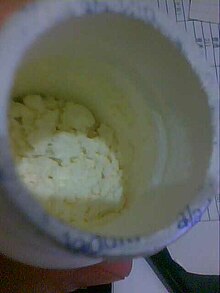Samarium(III) oxide

| |
| Names | |
|---|---|
| Other names
samarium sesquioxide
| |
| Identifiers | |
| ECHA InfoCard | 100.031.845 |
CompTox Dashboard (EPA)
|
|
| Properties | |
| Sm2O3 | |
| Molar mass | 348.72 g/mol |
| Appearance | yellow-white crystals |
| Density | 8.347 g/cm3 |
| Melting point | 2335°C |
| insoluble | |
| Structure | |
| cubic | |
Except where otherwise noted, data are given for materials in their standard state (at 25 °C [77 °F], 100 kPa).
| |
Samarium(III) oxide (Sm2O3) is a chemical compound.
Uses
Samarium(II) oxide is used in optical and infrared absorbing glass to absorb infrared radiation. Also, it is used as a neutron absorber in control rods for nuclear power reactors. The oxide catalyzes dehydration of acyclic primary alcohols to aldehydes and ketones. Another use involves preparation of other samarium salts. [1]
Preparations
Samarium(III) oxide may be prepared by two methods:
1. thermal decomposition of samarium(III) carbonate, nitrate, oxalate or sulfate:
- Sm2(CO3)3 → Sm2O3 + 3 CO2
2. by burning the metal in air or oxygen at a temperature above 150 °C:
- 4 Sm + 3 O2 → 2 Sm2O3
Reactions
Samarium(III) oxide dissolves in mineral acids, forming salts upon evaporation and crystallization:
- Sm2O3 + 6 HCl → 2 SmCl3 + 3 H2O
The oxide can be reduced to metallic samarium by heating with a reducing agent, such as hydrogen or carbon monoxide, at elevated temperatures.
References
- ^ Pradyot Patnaik. Handbook of Inorganic Chemicals. McGraw-Hill, 2002, ISBN 0070494398
